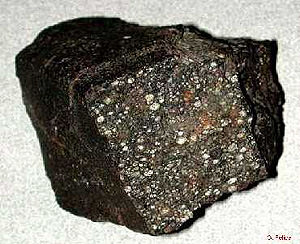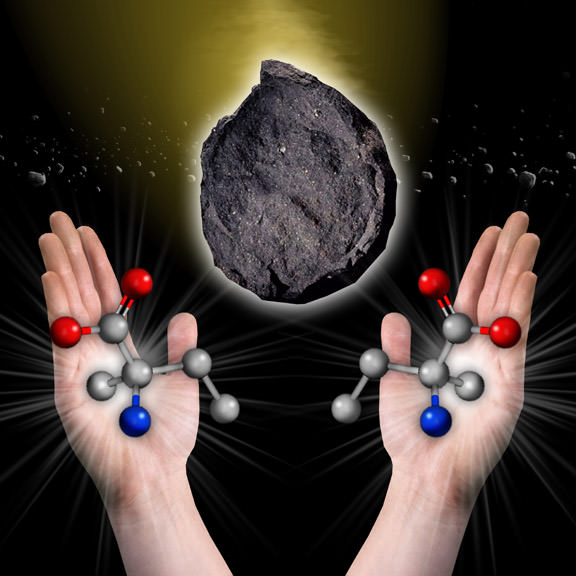Researchers have teased ammonia of a carbon-containing meteorite from Antarctica, and propose that meteorites may have delivered that essential ingredient for life to an early Earth.
The results appear today in the Proceedings of the National Academy of Sciences, and add to a growing body of evidence that meteorites may have played a key role in the development of life here. The NASA graphic at left was released just last month, when researchers reported that meteorites may have also delivered Earth’s first left-hand amino acids.

Lead author Sandra Pizzarello, of Arizona State University, and her colleagues note in the new paper that carbonaceous chondrites are asteroidal meteorites known to contain abundant organic materials.
“Given that meteorites and comets have reached the Earth since it formed, it has been proposed that the exogenous influx from these bodies provided the organic inventories necessary for the emergence of life,” they write.
The carbonaceous meteorites of the Renazzo-type family (CR) are known to be especially rich in small soluble organic molecules, such as the amino acids glycine and alanine. To test for the presence of ammonia, the researchers collected powder from the much-studied CR2 Grave Nunataks (GRA) 95229 meteorite and treated it with water at high temperature and pressure. They found that the treated powders emitted ammonia, NH4, an important precursor to complex biological molecules such as amino acids and DNA, into the surrounding water.
Next, the researchers analyzed the nitrogen atoms within the ammonia and determined that the atomic isotope did not match those currently found on Earth, eliminating the possibility that the ammonia resulted from contamination during the experiment. Researchers have struggled to pinpoint the origin of the ammonia responsible for triggering the formation of the first biomolecules on early Earth. The authors suggest that now, they may have found it.
“The findings appear to trace CR2 meteorites’ origin to cosmochemical regimes where ammonia was pervasive, and we speculate that their delivery to the early Earth could have fostered prebiotic molecular evolution,” they write.
Source: Pizzarello et al., Abundant ammonia in primitive asteroids and the case for a possible exobiology.


Huh..?
“They found that the treated powders emitted ammonia, NH4, an important precursor to complex biological molecules such as amino acids and DNA, into the surrounding water.”
So which is it? Ammonia (NH3) Or Ammonium (NH4)?
Or is it Ammonaiacal Nitrogen which is a combination of both (the first step of the APHA method involves acidification which converts all of the Ammonia to Ammonium).
You know, it’s also possible that life itself arrived at Earth from an extraterrestrial source. The theory is called Panspermia. I just wrote a post about how microbial life could be transferred between Earth and Mars via catastrophic impacts from space. It’s how meteorites found in Antarctica can be “Martian meteorites”. They were thrown from Mars into space by an enormous comet or asteroid that hit Mars a long time ago.
Montejo, transpermia explains nothing. Mars was never more alive than Earth and the act of getting rocks from there to here is hard enough without considering transferring rocks WITH life aboard, keeping it alive for the journey and re-entry and having it like its new home enough to propagate and evolve. Besides, why do we need to go off-planet for an explanation of a virtually impossible act? Earth and Mars were formed simultaneously except that maybe Mars avoided the moon formation impact that would have set Earth’s cooling back a bit. Yes, we have Mars rocks sitting around on Earth but something tells me they are as dead as the soils we’ve investigated on the angry red planet.
True, transpermia doesn’t explain the fundamental origin of life. It’s not a very likely scenario, but more of a remote possibility. It’s interesting nonetheless. Wouldn’t YOU want to know whether all life on Earth descended from Martians?
First, to play the numbers game on the hypothesis:
The planet most likely to originate life is Earth.
As for transpermia transport, cells would have to survive two impacts and a long journey in between. Too small a carrier body, and cosmic radiation would fry the inactive DNA. Too large a carrier body, and mineral radioactivity would fry it. It is inherently much less likely.
Given that it could happen, transpermia Mars – Earth is much more likely than Earth-Mars since a more massive Earth ups the delta-v requirement on the original hypervelocity impactor while at the same time makes a larger target for carrier bodies.
Second:
A priori we can’t test that hypothesis. If we would discover cells with the same LUCA, we wouldn’t know the transport direction even if we could assess the likelihood. Maybe some specific condition would allow us to test, but I don’t see how at the moment. Ideas?
The main interest in Earth/Mars transpermia would likely be that it could confirm that it happens, as some astrophysicists believe. If Earth is seeding the habitable volumes of the solar system, say Enceladus or Europa oceans, it would be a big deal for astrobiology research.
“transpermia Mars – Earth is much more likely than Earth-Mars”
Let me see:
1. Earth escape velocity is ~ 10 km/s, Mars ~ 5 km/s. OTOH, asteroids would exceed both of those at ~ 20-30 km/s delta-v at Earth, so in fact it would make little difference in resulting escapes.
2. IIRC, the gravitational capture area of Earth relative to the Moon is ~ 20, so say ~ 10 to Mars.
So “much more likely” is in fact roughly but an order of magnitude difference. At a guess, the likelihood for abiogenesis on Earth relative Mars would more than make up for that. So, modulo differences in crust formation times (on the order of tens of My), I have to retract my claim. Earth seeding Mars is what we should expect, I believe.
What a discovery it would be to find a rock of Earthly origin on Mars. Unfortunately, despite Mar’s geologic (and biologic) inactivity, surface winds would probably erode such rocks away. Or at least hide them under sand.
The moon is a different matter however. Ideas of panspermia might be greatly informed by a search for Earthly rocks on the lunar surface, where they would likely have gone undisturbed for millions of years. It certainly would be no easy search, however.
To be precise, I think that only applies for non-acidic (non-hydrogenated) atmospheres. And even then, hydrothermal vents may drive chemistry locally.
To be clear as well, NH3 doesn’t seem to be the precursor to amino acids in meteorites as much as HCN.